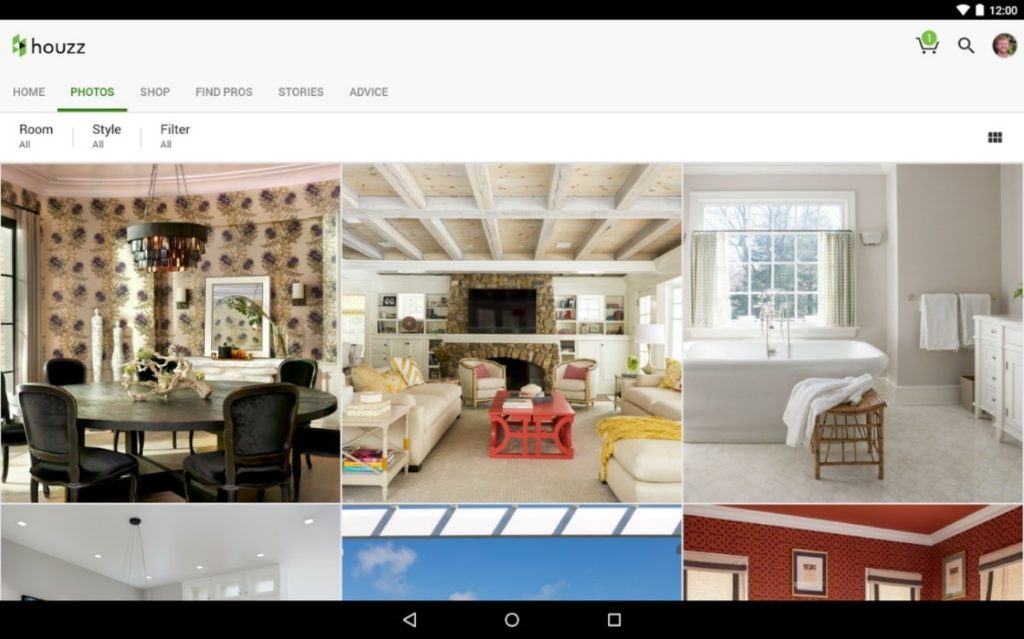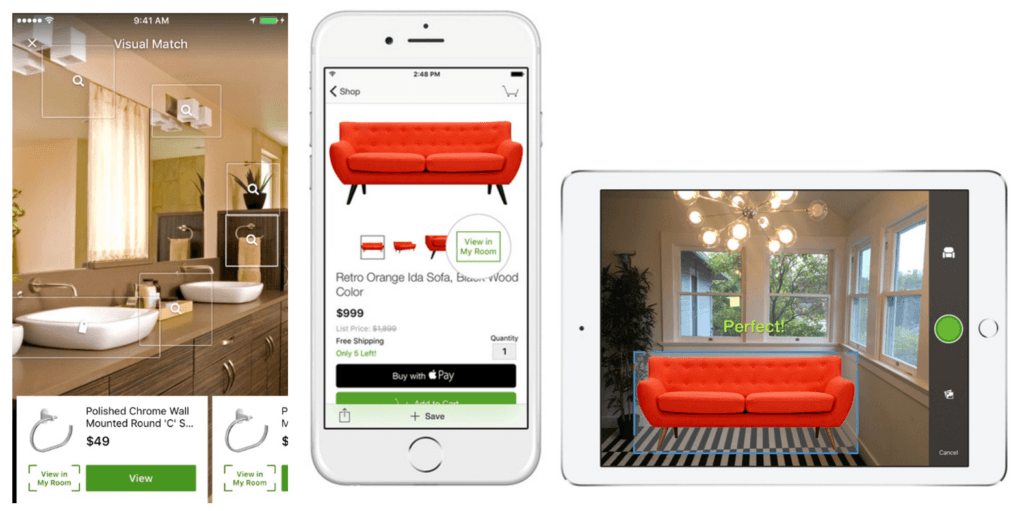Furnish your future apartment or home through the power of Artificial Intelligence

By the end of this post, you will understand how AI can help you furnish your future apartment or home!
Soon, you will own a nice apartment or home. And you’ll want to furnish it, decorate it, and make it your own. What digital transformations might help you personalize your future abode?
If you recall from Angie’s List, the company decided to add a free tier to entice more user memberships, hoping this would entice service providers on the platform to continue paying for advertising [1]. As a company that relies heavily on advertising revenues for nearly 80% of its revenues however, Angie’s List could use alternative ways of creating and capturing value.
One of its smaller and more recent competitors, Houzz, is seeking to diversify its revenue streams and be more relevant to millennials. Houzz, an online home improvement marketplace, is free for users and creates value for service providers (think architects, designers) by providing them a place to upload photos of their work to casual users who may be thinking about redecorating, redesigning or furnishing their apartments or homes. As a platform, Houzz captures value by charging for premium listings.
Fig 1: Houzz’s website, a Pinterest-like display of service providers’ photos of home interiors and exteriors. But what if you want some of the furniture or other items in the photo?
Unlike Angie’s List, though, Houzz also earns additional revenue streams by featuring advertisements from major merchants (like IKEA and Black&Decker) and through e-commerce commissions on products users see in the photos (Fig 2). In terms of operations, service providers and Houzz staff must explicitly and laboriously tag each product in the photo, and if the product is already in Houzz’s database (thanks to its partnerships with certain merchants), users can buy the item through a link to the product’s website.
Fig 2: After Houzz’s deep learning algorithm recognizes the products in the photo, Houzz’s Visual Match tool can also show you how products will appear in your own home [3]. Neat!
For Houzz to achieve its customer promise of providing customers the ability to buy any item in its photos, it needs to overcome two limitations. The first is that many service providers do not know what products are in the photos they are taking – they are selling the interior design, or the porch, not necessarily the furniture or appliances. Having the service manually fill in the products in their photos when they are uploading is a nuisance. The second is that although Houzz’s marketplace contains 11 million photos, only 6 million products can be purchased through its database (that’s fewer than one product per photo) [2]. Just looking at the photo below, 6 products appear in just one picture, so there seems to be a bottleneck in terms of tagging products in these photos.
To automate the task of marking items in a photo for sale, Houzz has begun to use software to scan service provides’ photos for products that look like those already in Houzz’s database. The software is based on an advanced method of data analysis known as deep learning. With deep learning, the goal is to get software to recognize things like facial features the same way that our human brain does – by first detecting simple patterns and then using them as building blocks to detect more complex patterns [4]. Houzz’s engineers train their deep learning algorithm on pictures of products already in the database (e.g. tables, sofas, chairs) so that when the algorithm encounters a new photo, it can accurately identify what the product in the photo is and whether it exists in the database.
While automatically recognizing products in photos is an important new feature, an additional step that Houzz should be thinking about is how to get more items into its database, so that its deep learning algorithm can find virtually any product in any photo of a room, patio, or yard. By coincidence, just the other day I had a discussion with a fellow HBS CODE club member about a web crawling tool he is currently developing. Given a list of keywords (say, of various furniture) to be queried, and a way to look up the prices and websites for those keywords, this tool can autonomously query (or web scrape, as they call it) websites and automatically export into another file the prices and link information for thousands of products at a time. Such a tool, while still in testing phase, can conceivably be used to greatly expand Houzz’s database. With Ericsson predicting worldwide smartphone subscriptions projected to double to 6 billion by 2020, smartphone camera resolution increasing by a megapixel a year, and trillions of photos uploaded to the cloud annually, Houzz’s investments in deep learning should be a useful tool for future homeowners like you and me [5]. (782 words)
Sources:
[1] Dolan, Robert J., and Ayelet Israeli. “Angie’s List: Ratings Pioneer Turns 20.” Harvard Business School Case 517-016, September 2016.
[2] Lardinois, Frederic Houzz now uses deep learning to help you find and buy products in its photo https://techcrunch.com/2016/09/14/houzz-now-uses-deep-learning-to-help-you-find-and-buy-products-in-its-photos/ TechCrunch.com, Sept 14, 2016.
[3] http://www.houzz.com/ideabooks/61877912/list/inside-houzz-introducing-view-in-my-room Houzz.com, February 17, 2016.
[4] https://www.youtube.com/watch?v=CEv_0r5huTY Deep Learning, Simplified. Published Dec 11, 2015 by DeepLearning.TV





Thanks Paul for the piece! I love the concept for Houzz and I think that it has huge potential especially if the algorithms to “web scrape” become more powerful. My only question/concern with this type of app is on accessibility. Is it linked in any way to geo-location? My reason for asking is if I’m using this tool to furnish my apartment in New York City, I might come across an image with a couch I really like. If it links me to a page with that couch but the store is a boutique based in California that could cause issues. Either I’d have to pick it up across the country or they would send it to me. Chances are shipping will be the option an app like this would use, but shipping single items of these dimensions and weight can be costly. As a customer, I would not want to pay the massive shipping fees to get that couch, I’d probably look for something similar in NYC to save myself some money. Do they have a way to ensure they don’t lose customers for these logistical reasons?
Paul, thanks for enlightening all of us with Houzz, which could be an app that all of us use once we move into our post-HBS lives.
As Orianne mentioned, the ability to source local furniture or furnishings is certainly an area of concern for me because of the cost involved to transport furniture. Another area of concern is the geo-tagging feature that Orianne mentioned. My biggest concern about geo-tagging is the ability for a stranger to gain access to your address. Please see my questions and thoughts below about the app.
1) How is Houzz thinking about data privacy and data security? In a world where we have endless amounts of data being collected, a company’s ability to prevent private data to be hacked or leaked is of utmost importance to customers. It would be great to know how Houzz is approaching data privacy with their model, especially if the geo-tagging feature is used.
2) Does the app only search the internet for furniture or furnishings that are in production? It would be extremely annoying as a customer for the searches to recommend items that are no longer in production because it would be a waste of time. I do hope the deep learning algorithm will be updated to include only items that are currently in production.
3) Can the app use inputs such as price ranges to filter results? The ability to filter by brand, color, type, etc. makes the online shopping experience extremely easier because it eliminates the time it takes to find an item that meets the needs of the customer.
Houzz is an app that is appealing for the reasons you noted in your article, and I also believe it would be of use to the construction or hotel industry. It will be neat to see which markets Houzz will target and their strategy to increase the number of users.
Amazing article! I stumbled upon Houzz while furnishing my current apartment and thought it was great. While I agree that the number of tagged products is an issue, I think they’ve done a great job utilizing pattern recognition software to link customers to related (if not the exact) products. I think an additional feature that would be incredibly useful to consumers would be the ability to find similar looking products at a variety of price points. Currently you can click on a product and see related products, but they tend to just be the same category of product rather than of the same style. I also think there’s room for improved pattern recognition in terms of matching the style of sponsored products to the style of the photo that the customer is looking at – or alternatively a lower tech way of doing this would be to categorize each photo and sponsored product with key words (“mid-century modern” “shabby chic”) and match those up.
Very interesting an useful app! As mentioned by both Orianne and Jose, the cost of implementing some of these suggestions can run quite high and prevent users from fully benefiting from the experience. As mentioned in other TOM classes, some very successful companies are actually disguised as completely different types of firms. Might houzz actually benefit from being a supply chain app than a design tool for apartments? If clients had an easy way to match up furniture and instantaneously have it in their home, like the Casper mattresses, this could be a significant strength for the company.
Very cool! I think Houzz would be wise to focus on their Visual Match tool – if I’m lucky enough to rent a nice apartment one day, I could definitely see myself trying it out! On the other hand, the other side of their business – serving as a broker between homeowners and home service providers – lies in a crowded ecosystem that is under a serious amount of pressure from external forces. That side is built on a dying business model; to put it into context, the Angie’s List turnaround is going terribly and I’m currently shorting the company. HomeAdvisor, which is owned by InterActive Corp., is showing signs of weakness as well. I hope to see that Houzz will continue to pursue revenue streams outside of the typical home service brokerage business.